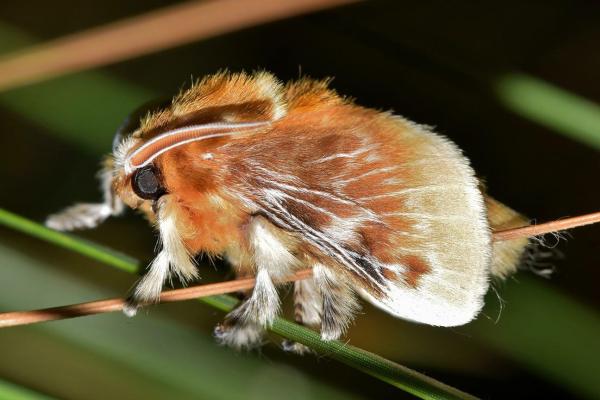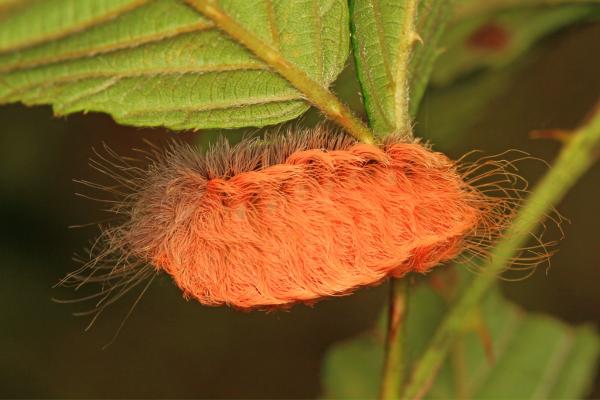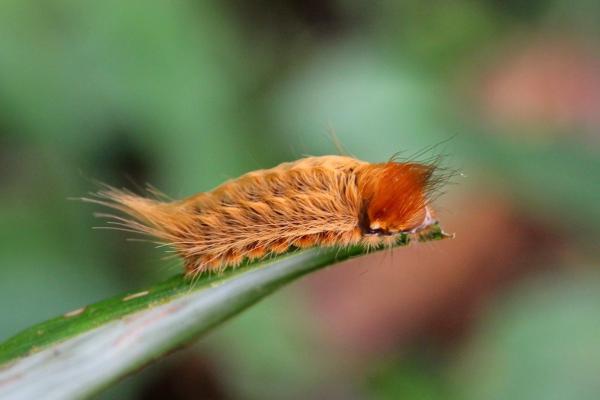The plush caterpillar, also known as the woolly slug, is the larval stage of the moth Megalopyge opercularis. It is notable for its unusual appearance, resembling a tiny furry mammal. Despite its cute look, it is highly venomous and one of the few poisonous moth species. In this article, we will explore the characteristics of the plush caterpillar, its sting effects, where it is found, and what to do if you get stung.

The plush caterpillar is an early developmental stage of a moth, which later undergoes metamorphosis into a winged adult. It is covered with long, soft hairs called setae that can be brown, white, golden, or gray. A bright orange longitudinal stripe runs along its back, where the hairs form a crest.
There are two types of setae:
Venomous setae: short, sharp, and capable of injecting toxins.
Non-venomous setae: longer, colorful, and harmless.
The caterpillar also has eight pairs of sucker-like false legs (prolegs) for movement and measures between 2.5 to 3.5 centimeters long.
The adult moth looks similarly furry with orange to yellow colors and black legs, maintaining the fuzzy appearance.

The plush caterpillar’s venomous hairs serve as a defense mechanism against predators such as lizards, birds, parasites, and other insects. These hairs contain neurotoxic, proteolytic, and allergenic venom.
Known since pre-Hispanic Mexico as chinaláhuatl ("burning hair"), these stings cause hundreds of human envenomations annually, mostly from July to November when caterpillars emerge. In the US alone, 3,484 cases were reported between 2000 and 2016.
When the venomous hairs penetrate the skin, they release toxins causing symptoms like:
Intense pain, often compared to wasp stings or broken bones
Burning sensation
Redness, swelling, papules, or hives
Localized paralysis
Nausea, vomiting
Chest pain and headache
Severe allergic reactions or respiratory distress in sensitive individuals
No deaths have been reported from these stings.

While some treat stings with ice, baking soda, antihistamines, or oatmeal compresses, medical attention is strongly advised.
Medical professionals may administer opioids (codeine, morphine), corticosteroids to reduce inflammation, and monitor for allergic reactions. If hairs contact the eyes, ophthalmologic evaluation is necessary.
Avoid touching or trying to remove hairs manually to prevent toxin spread or infection.
The plush caterpillar inhabits the Americas, from the United States through Mexico and Central America to northern South America.
They form clusters on tree bark and leaves and tend to inhabit:
Forests
Citrus groves
Eucalyptus
Acacia
Oak trees
Pine trees
Ornamental trees
The caterpillars’ falling hairs cause most accidental stings.
The diet varies by developmental stage but is primarily plant-based. The larval stage feeds on deciduous tree and shrub leaves, while adult moths lay eggs on host plants for the next generation.
Plush moths have separate sexes, reproduce sexually with internal fertilization, and undergo complete metamorphosis: egg, larva (caterpillar), pupa, and adult.
They produce two larval generations annually, corresponding to dry and rainy seasons. Adults live about one week after emerging.
If you want to learn more about the plush caterpillar or insect metamorphosis, check out related articles in our Wild Animals section.
Bibliography
Eagleman, D. M. (2008). Envenomation by the asp caterpillar (Megalopyge opercularis). Clinical Toxicology, 46(3), 201-205.
Avilán, L., Guerrero, B., Álvarez, E., & Rodríguez-Acosta, A. (2010). Description of envenomation by the “chicken worm” caterpillar (Megalopyge opercularis) in Venezuela. Clinical Investigation, 51(1), 127-132.
Rodríguez, W. D., Valderrama, M., & Guapo, L. A. (2021). The stuffed caterpillar: a tender and poisonous butterfly. AMXSA Bulletin, Volume 5 (1).
animal tags: Plush Caterpillar
We created this article in conjunction with AI technology, then made sure it was fact-checked and edited by a Animals Top editor.